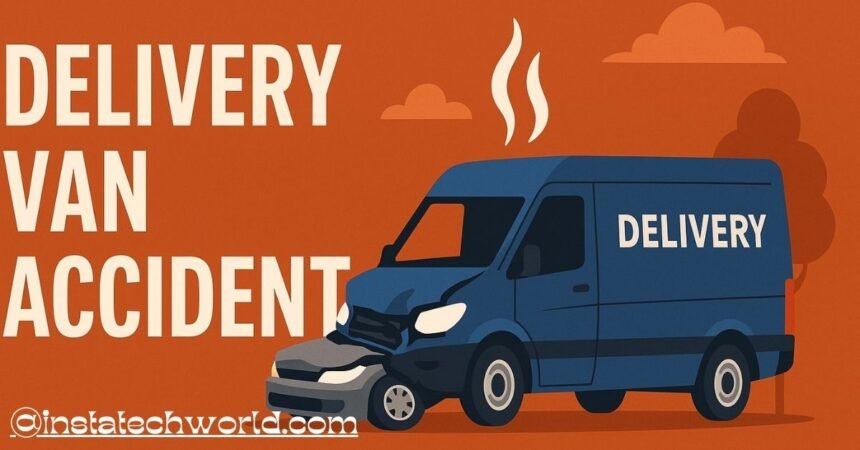With the growing demand for online shopping and fast delivery services, delivery vans have become a constant presence on our roads. While they play a crucial role in meeting consumer needs, they also contribute to a rising number of traffic accidents. The increased volume of delivery vehicles means more chances for collisions, especially in congested urban areas. Factors such as tight schedules, distracted driving, and overworked drivers all contribute to the issue. Understanding why these accidents happen is the first step toward preventing them and ensuring safer roads for everyone—drivers, pedestrians, and other motorists alike.
Common Causes Behind Delivery Van Accidents
Many delivery van accidents stem from a mix of human error and external conditions. Speeding to meet tight deadlines is a major culprit, often leading drivers to take risks they normally wouldn’t. Fatigue is another serious issue—long hours on the road can impair judgment and slow reaction times. Distracted driving, whether it’s checking a GPS or a phone notification, can lead to devastating consequences in just a split second. Additionally, poorly maintained vehicles, adverse weather, and complex delivery routes can increase the risk of an accident. All these factors, when combined, create a dangerous environment for both the driver and others on the road.
The Immediate Impact of a Van Accident
When a delivery van is involved in an accident, the consequences can be severe. In the worst cases, these incidents result in injuries or fatalities, not only for the van driver but also for passengers, pedestrians, and occupants of other vehicles. Beyond physical harm, there’s also the emotional trauma that victims may experience, which can linger long after the physical wounds heal. For the delivery company, even a single accident can mean damaged goods, delayed shipments, insurance claims, legal liability, and a blow to their reputation. The ripple effect of one incident can stretch far beyond the scene of the crash, affecting lives and livelihoods.
Legal and Financial Consequences
Accidents involving commercial vehicles often come with serious legal and financial ramifications. If a driver is found to be at fault, they—and the company they work for—could be held liable for property damage, medical expenses, and other costs. Lawsuits can arise, especially if negligence such as distracted driving or a lack of vehicle maintenance is proven. Insurance premiums may spike, and some companies may face regulatory penalties or even lose their licenses to operate if they’re found to be in repeated violation of safety protocols. These legal battles can be both time-consuming and costly, further underscoring the importance of accident prevention.
Safety Tips for Delivery Van Drivers
To avoid becoming part of the accident statistics, delivery van drivers should prioritize safety above speed. It starts with proper training—not just in handling a van, but also in defensive driving techniques. Taking regular breaks to avoid fatigue, avoiding phone use while driving, and sticking to speed limits can make a huge difference. Planning routes ahead of time and using technology responsibly also reduces stress and distractions. Most importantly, drivers should communicate openly with their employers about any challenges they face so that safety isn’t sacrificed in the name of productivity. Safe driving isn’t just about rules—it’s about habits.
How Companies Can Prevent Accidents
Delivery companies have a huge role to play in accident prevention. It starts with hiring qualified, well-trained drivers and ensuring vehicles are regularly inspected and maintained. Employers should avoid placing unrealistic expectations on drivers that might pressure them into speeding or skipping rest breaks. Investing in driver education programs, implementing fleet tracking systems, and setting clear safety standards can all contribute to a culture where safety comes first. Encouraging open dialogue and feedback from drivers also helps companies better understand the challenges on the road. A strong focus on safety not only protects people but also strengthens a company’s credibility and trustworthiness.
Technology’s Role in Enhancing Safety
Modern technology is revolutionizing vehicle safety, and delivery vans are no exception. GPS and route optimization software help drivers avoid congested areas and reach destinations more efficiently. Dashcams provide crucial footage in case of an accident and encourage responsible driving. Some vans now include built-in safety features like collision warning systems, lane departure alerts, and automatic emergency braking. Fleet management tools allow companies to monitor driver behavior, vehicle health, and route performance in real time. When used responsibly, these tools can drastically reduce the number of accidents and create a safer working environment for everyone involved.
The Role of the Public in Preventing Accidents
While delivery companies and drivers carry the bulk of responsibility, the general public also plays a part in keeping roads safe. Giving delivery vans enough space, being patient around slow or turning vehicles, and staying alert—especially in areas with frequent deliveries—can help prevent unnecessary accidents. Pedestrians should avoid sudden crossings in front of vans, and cyclists should stay visible and avoid blind spots. Road safety is a shared effort, and when everyone plays their part, the outcome is safer streets and fewer tragedies.
Reporting and Responding to a Van Accident
If you’re ever involved in or witness a delivery van accident, knowing how to respond is critical. Call emergency services immediately if there are injuries. If it’s safe, help secure the scene to prevent further accidents. Exchange information and take pictures of any damages if you’re directly involved. Reporting the incident to authorities and the delivery company helps ensure that proper investigations can take place. Timely reports can also prevent similar accidents in the future by identifying patterns or issues that need fixing. Quick, calm, and responsible action can save lives and lead to better outcomes for everyone involved.
The Emotional Toll on Drivers
One often overlooked aspect of delivery van accidents is the emotional toll they take on the drivers. Even in minor incidents, drivers may carry guilt, anxiety, or fear long after the event. This emotional stress can affect their confidence, focus, and overall well-being. Some may even leave the profession altogether if the trauma is too intense. Companies should offer counseling services and mental health support for drivers involved in accidents. Recognizing and addressing the emotional impact is just as important as dealing with the physical or legal aftermath.
Insurance Considerations for Delivery Drivers
Insurance is a critical piece of the puzzle when it comes to delivery van accidents. Commercial auto insurance policies usually cover these vehicles, but not all policies are created equal. Some drivers who use personal vehicles for delivery may find themselves without proper coverage if they’re in an accident. It’s essential for both companies and independent contractors to understand what their policy includes and ensure that they are protected in case of an incident. Inadequate insurance can lead to devastating out-of-pocket expenses, adding financial strain on top of an already stressful situation.
Long-Term Business Impact of Accidents
Beyond the immediate financial and legal costs, delivery van accidents can have a long-term impact on a business. Customer trust can erode if shipments are delayed or products are damaged. News of a severe accident might go viral, damaging a company’s reputation. Insurance premiums can rise significantly, cutting into profit margins. Plus, constant accidents signal a deeper issue in a company’s operations or culture that needs to be addressed. Fewer qualified drivers may want to work for a company with a poor safety record. Ultimately, focusing on prevention isn’t just the right thing to do—it’s good business.
Also read:








